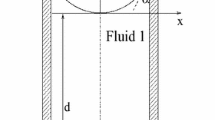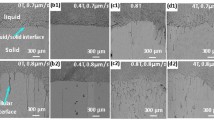Abstract
A mechanical analysis is done to find the evolution of the interface profile between binary immiscible fluids induced by a three-dimensional orthogonal magnetic field gradient. In the experiments, the changes of the interface profile between four groups of binary immiscible fluids are investigated under the same horizontal magnetic field gradients. The binary immiscible fluids are made of benzene and other liquids, like CuSO4, Fecl3, FeSO4 or Cucl2 aqueous solutions. In addition, the interface profile between the benzene and CuSO4 aqueous solution is examined under different horizontal magnetic field gradients. The experimental results are consistent with the theoretical analysis. This study explains the enhanced Moses effect from a mechanics standpoint. Furthermore, a new method for susceptibility measurement is proposed based on this enhanced Moses effect.
Similar content being viewed by others
References
Nakagawa J, Hirota N, Kitazawa K, et al. Measurement of oxygen pressure increase in magnetic field. IEEE Trans Magn, 1998, 34: 2024–2026
Iwasaka M, Ikehata M, Miyakoshi J, et al. Strong static magnetic field effects on yeast proliferation and distribution. Bioelectrochem, 2004, 65: 59–68
Guillot M, Schmiedel T, Xu Y. Faraday rotation and magnetic properties of erbium gallium gallate under high magnetic field. J Appl Phys, 1998, 83: 6762–6764
Bacaltchuk C M B, Castello-Branco G A, Gault B, et al. Effect of high magnetic field during primary annealing on texture of silicon steel. In: Chandra T, Torralba J M, Sakai T, eds. Thermec’ 2003, PTS1-5, Vol. 426-4. Uetikon-Zurich: Trans Tech Publications Ltd, 2003. 3733–3738
Kitazawa K, Ikezoe Y, Uetake H, et al. Magnetic field effects on water, air and powders. Physica B-Condens Matter, 2001, 294: 709–714
Wang Q, Liu T, Gao A, et al. A novel method for in situ formation of bulk layered composites with compositional gradients by magnetic field gradient. Scr Mater, 2007, 56: 1087–1090
Kang J Y, Tozawa S. Crystal growth in a high magnetic field (in Chinese). Acta Phys Sin, 1996, 45: 324–329
Feng Q Y, Li T J, Zhang Z T, et al. Preparation of nanostructured Ni/Al2O3 composite coatings in high magnetic field. Surf Coat Technol, 2007, 201: 6247–6252
Wang H, Ren Z M, Xu K D, et al. Solidification behaviors of Al3Ni precipitated phase in Al-Ni alloy under a high magnetic field (in Chinese). Rare Met Mat Eng, 2005, 34: 1033–1035
Wang Q, Lou C S, Liu T, et al. Fabrication of MnBi/Bi composite using dilute master alloy solidification under high magnetic field gradients. J Phys D-Appl Phys, 2009, 42: 025001
Ueno S, Iwasaka M. Properties of diamagnetic fluid in high gradient magnetic fields. J Appl Phys, 1994, 75: 7177–7179
Hirota N, Homma T, Sugawara H, et al. Rise and fall of surface level of water solutions under high magnetic-field. Jpn J Appl Phys, 1995, 34: L991–L993
Sugawara H, Hirota N, Homma T, et al. Magnetic field effect on interface profile between immiscible nonmagnetic liquids-Enhanced Moses effect. J Appl Phys, 1996, 79: 4721–4723
Wang Q, He J C. Apparatus for controlling fluid flow and current switch. PRC Patent, CN 1716139A, 2005-07-11
Uemura T, Kimura T, Sugitani M, et al. Formation of contact holes on bumps on semiconductor chip by micro-Moses effect. Adv Mater, 2006, 18: 1549–1551
Ding Z R. Fluid Mechanics (in Chinese). Beijing: Higher Education Press, 92
Wang Q, Zhao L J, You Y, et al. Method and device for measurement of magnetic susceptibility based on enhanced Moses effect. PRC Patent, CN 101419273A, 2008-11-14
Author information
Authors and Affiliations
Corresponding author
Rights and permissions
About this article
Cite this article
Zhao, L., You, Y., Tian, Y. et al. Interface profile evolution between binary immiscible fluids induced by high magnetic field gradients. Sci. China Phys. Mech. Astron. 53, 1319–1324 (2010). https://doi.org/10.1007/s11433-010-3201-4
Received:
Accepted:
Published:
Issue Date:
DOI: https://doi.org/10.1007/s11433-010-3201-4




